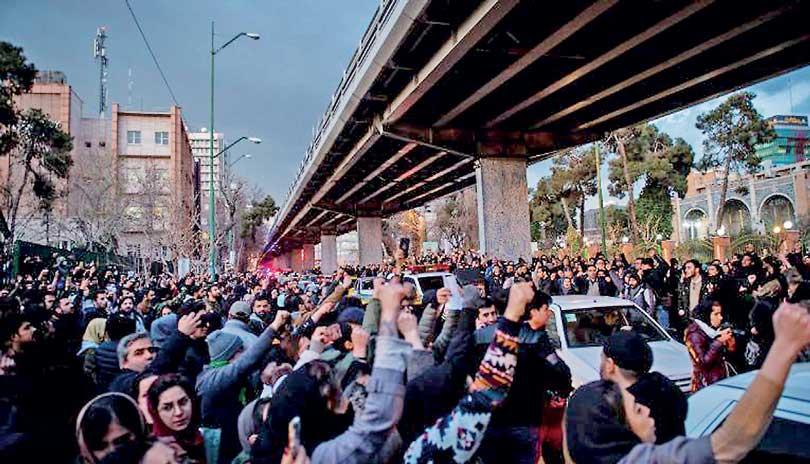Reply To:
Name - Reply Comment
Last Updated : 2024-05-03 00:02:00

 The United States’ 40-year sanctions-based economic war against the radical Islamic regime in Iran may end in the not too distant future, if the regime gives in to the growing domestic demand for an end to a dictatorship masquerading as a democracy.
The United States’ 40-year sanctions-based economic war against the radical Islamic regime in Iran may end in the not too distant future, if the regime gives in to the growing domestic demand for an end to a dictatorship masquerading as a democracy.
Events in the past two or three months appear to justify the US claim that US and international sanctions have crippled the Iranian economy, and that more of these will definitely bring the Islamic authoritarian regime to its knees. Following the pathetic admission of the Iranian government that its forces had mistakenly shot down an Ukrainian passenger airliner over Iran killing all the 176 persons on board, hundreds of Iranians began to protest against their regime in Tehran on Saturday.
This would have come as a shock to Supreme Leader Ali Hosseini-Khamenei and the Head of the government, President Hasan Fereidun Ruhani for only the other day, thousands of Iranians had hit the streets to mourn the death of the Revolutionary Guards leader and a pillar of the Khamenei government, Gen. Qasem Soleimani.
 Videos posted on social media showed demonstrators outside Tehran’s Amirkabir University chanting slogans urging Supreme Leader Ayatollah Khamenei to resign. The slogans included: “Death to the dictator,” “Shame on you Khamenei, Leave the country,” “Death to the liars,” and “Shame on the Revolutionary Guards,” One protester said: “They are lying that our enemy is America, our enemy is right here.” There were similar protests in other universities in Iran.
Videos posted on social media showed demonstrators outside Tehran’s Amirkabir University chanting slogans urging Supreme Leader Ayatollah Khamenei to resign. The slogans included: “Death to the dictator,” “Shame on you Khamenei, Leave the country,” “Death to the liars,” and “Shame on the Revolutionary Guards,” One protester said: “They are lying that our enemy is America, our enemy is right here.” There were similar protests in other universities in Iran.
Even as the people mourned a war hero’s death they had serious complaints against Ayotollah Khamenei’s regime which had become dictatorial and policies of which had led to crippling US and UN-backed sanctions. Iran’s impoverished common man had put up with over 40 years of sanctions but had reached the end of his tether.
Nov.-Dec. agitation
There was a forewarning of this in November-December 2019.At that time Iran experienced its deadliest political unrest since the Islamic Revolution of 1979, which overthrew a US-backed monarchy. At least 631 people were killed in November-December 2019 as angry protesters faced unbridled government aggression. At least 2,000 were wounded and 7,000 arrested.
The immediate cause of the protest at that time was an abrupt increase of at least 50% in petrol prices. Within 72 hours, outraged demonstrators, in cities large and small, were demanding an end to the Islamic government. The protesters were mostly unemployed or low-income young men between the ages of 19 and 26.
The use of lethal force against people throughout the country was unprecedented, even by the standard of the Islamic Republic and its record of violence, said Omid Memarian, Deputy Director at the Centre for Human Rights in Iran. The protesters quickly shifted their emphasis from gas prices to the economy and the Establishment. “Death to Khomeini, the Supreme Leader, death to the dictator,” rent the air.
As one account put it, clearly there was a lot of pent-up anger and frustration over a host of things, from financial corruption, to unemployment, inflation. People resented the government’s telling them how to dress, how to think, what to do, and where to go. The sudden spurt in petrol prices was only the last straw. The prices of basic goods like bread, dairy, meat, everything had increased by at least 20% because transportation costs had increased.The US sanctions of course were the main cause of the misery. But the people blamed the government for ceaselessly confronting the US and making the common man pay for it.
When the 2015 nuclear deal between Iran and the world was signed and sanctions were lifted, the economic situation eased in Iran. There was even hope of getting FDI which would generate jobs and income. And when President Trump walked out of the agreement and revived sanctions in 2018, misery returned. The Iranian currency went into a tailspin.
During the November-December struggle, the US brazenly encouraged the protesters. The Special Envoy to Iran, Brian Hook, said: “We’re very pleased to see the protests across Iran.” Secretary of State Mike Pompeo tweeted that he asked Iranian protesters to communicate with him and send him video footage of the violence against them. Pompeo later revealed that the State Department had received nearly 20,000 messages, videos, pictures, notes of the regime’s abuses through Telegram messaging services.
Over time, the protests died out, but only to be revived by another incident in January 2020. The US-Iran shadow war had escalated with the Americans assassinating Iranian General Qasem Soliemani and the imposition of fresh economic sanctions after the Iranians fired missiles that hit a US base in Iraq.
This was followed by the downing of an Ukrainian passenger aircraft by the Iranians. Though Iran said it was a mistake and apologized, the people of Iran took a different view. They blamed the government saying that it does not get anything right and should therefore quit.
Sanctions have been a significant component of US’ Iran policy since Iran’s 1979 Islamic Revolution. The US lost access to Iran’s vast oil resources. Iran has the fourth largest reserves of oil in the world.
The US sanctions continued through the 1980s and 1990s, with Washington accusing Tehran of supporting terrorism. The US was also wanting to quash oil-rich Iran’s strategic ambitious in the Middle East.
President Jimmy Carter broke diplomatic relations with Iran on April 7, 1980 following the hostage crisis. But following the “Algiers Accords” and the setting up of a Tribunal to resolve US-Iran issues, sanctions were relaxed in 1981.
However, in 1983, Iran blew up the US Marine barracks at the US Embassy in Beirut, killing dozens of marines. The same year, an Iraqi, Abu Mahdi al-Muhandis, car-bombed the US Embassy in Kuwait.Al Munandis was an ally of the Iranian General Qasem Soleimani.
In the 2000s, the US and international sanctions focused on ensuring that Iran’s nuclear program is only for civilian use. Between 2010 and 2015, there were US and international sanctions.
When Barack Obama was President, the US and Iran arrived at a nuclear deal in 2015. But when Trump came to power the deal was revoked in 2018. This widened the rift with Iran which was keen on implementing the deal.
After the US killed Gen.Soleimani, Iran staged a missile attack on a US base in Iraq. The US retaliated by stepping up sanctions which would apply to senior Iranian officials involved in “destabilizing” the Middle East. Trump had also issued an executive order imposing sanctions on anyone involved in the Iranian textile, construction, manufacturing or mining sectors. Separate sanctions would be imposed against the steel and iron sectors it was reported. The US reinstated all the sanctions that were eased after the 2015 nuclear deal.
All this caused significant economic hardship in Iran and cut its oil exports to historic lows. “As a result of these actions, we will cut off billions of dollars of support to the Iranian regime,” US Treasury Secretary Steven Mnuchin said.
According to the CNBC, sanctions have visibly harmed the Iranian economy. Exports had come down from US$ 150 billion in 2011 to US$ 60 billion in 2019. Currency had depreciated from 42,000 Irani Riyals per US$ to 140,000 Irani Riyals per US$. Unemployment had gone up from 12.30 % in 2011 to 16.68% in 2019.
In the past 40 years of sanctions,Iran had, for the most part, the grit and determination to put up with them and get round them. But it may not be possible this time when it appears that fatigue has set in. The common man is fed up. He now wants to breathe the fresh air of freedom from war, sanctions and other hardships. The writing on the wall now is clear to the common man in Iran, and hopefully it will be clear to the leaders also, soon.

Add comment
Comments will be edited (grammar, spelling and slang) and authorized at the discretion of Daily Mirror online. The website also has the right not to publish selected comments.
Reply To:
Name - Reply Comment
US authorities are currently reviewing the manifest of every cargo aboard MV
On March 26, a couple arriving from Thailand was arrested with 88 live animal
According to villagers from Naula-Moragolla out of 105 families 80 can afford
Is the situation in Sri Lanka so grim that locals harbour hope that they coul